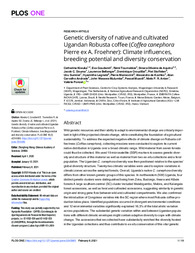Genetic diversity of native and cultivated Ugandan Robusta coffee (Coffea canephora Pierre ex A. Froehner): Climate influences, breeding potential and diversity conservation.
Genetic diversity of native and cultivated Ugandan Robusta coffee (Coffea canephora Pierre ex A. Froehner): Climate influences, breeding potential and diversity conservation.
Author(s): KIWUKA, C.; GOUDSMIT, E.; TOURNEBIZE, R.; AQUINO, S. O. de; DOUMA, J. C.; BELLANGER, L.; CROUZILLAT, D.; STOFFELEN, P.; SUMIRAT, U.; LEGNATÉ, H.; MARRACCINI, P.; KOCHKO, A. de; ANDRADE, A. C.; MULUMBA, J. W.; MUSOLI, P.; ANTEN, N. P. R.; PONCET, V.
Summary: Wild genetic resources and their ability to adapt to environmental change are critically important in light of the projected climate change, while constituting the foundation of agricultural sustainability. To address the expected negative effects of climate change on Robusta coffee trees (Coffea canephora), collecting missions were conducted to explore its current native distribution in Uganda over a broad climatic range. Wild material from seven forests could thus be collected. We used 19 microsatellite (SSR) markers to assess genetic diversity and structure of this material as well as material from two ex-situ collections and a feral population. The Ugandan C. canephora diversity was then positioned relative to the species? global diversity structure. Twenty-two climatic variables were used to explore variations in climatic zones across the sampled forests. Overall, Uganda's native C. canephora diversity differs from other known genetic groups of this species. In northwestern (NW) Uganda, four distinct genetic clusters were distinguished being from Zoka, Budongo, Itwara and Kibale forests A large southern-central (SC) cluster included Malabigambo, Mabira, and Kalangala forest accessions, as well as feral and cultivated accessions, suggesting similarity in genetic origin and strong gene flow between wild and cultivated compartments. We also confirmed the introduction of Congolese varieties into the SC region where most Robusta coffee production takes place. Identified populations occurred in divergent environmental conditions and 12 environmental variables significantly explained 16.3% of the total allelic variation across populations. The substantial genetic variation within and between Ugandan populations with different climatic envelopes might contain adaptive diversity to cope with climate change. The accessions that we collected have substantially enriched the diversity hosted in the Ugandan collections and thus contribute to ex situ conservation of this vital genetic resource. However, there is an urgent need to develop strategies to enhance complementary in-situ conservation of Coffea canephora in native forests in northwestern Uganda.
Publication year: 2021
Types of publication: Journal article
Unit: Embrapa Coffee
Observation
Some of Embrapa's publications are published as ePub files. To read them, use or download one of the following free software options to your computer or mobile device. Android: Google Play Books; IOS: iBooks; Windows and Linux: Calibre.
Access other publications
Access the Agricultural Research Database (BDPA) to consult Embrapa's full library collection and records.
Visit Embrapa Bookstore to purchase books and other publications sold by Embrapa.

